
Power Steering Malfunction – Complete Guide for Drivers
Power steering is one of the most important systems in modern vehicles. It makes steering smooth and effortless, allowing the driver to maintain better control at any speed. This system plays a key role in safe driving, especially during tight turns, parking, or emergency maneuvers.
When the power steering system develops a fault, it can affect the driver’s ability to steer easily. The steering wheel may become heavier and require more effort to turn. This can increase reaction time in critical situations and may lead to dangerous driving conditions if ignored.
The “Power Steering Malfunction – See Operator’s Manual” warning appears when the vehicle detects a problem in the steering system. It is a signal from the car’s onboard diagnostics that the system is not working as intended and may need immediate attention. Understanding this warning and acting quickly can prevent costly repairs and ensure the vehicle remains safe to drive.
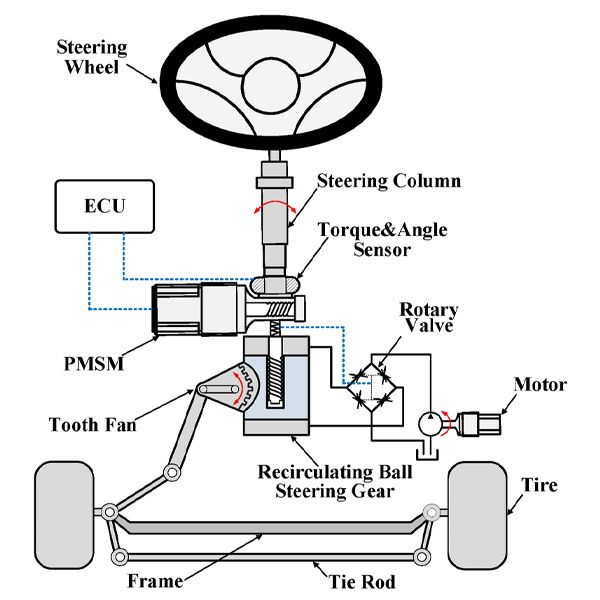
Types of Power Steering:
There are three main types of power steering systems in use today.
Hydraulic Power Steering (HPS):
This system uses a hydraulic pump driven by the engine. The pump circulates fluid through a steering rack or gearbox, applying pressure to assist the driver’s input. It’s reliable, but it requires regular fluid checks and can lose efficiency if there is a leak or pump failure.
Electric Power Steering (EPS):
EPS replaces the hydraulic pump with an electric motor. The motor provides steering assistance based on signals from sensors that monitor the steering angle, vehicle speed, and driver input. This system improves fuel efficiency and reduces maintenance since it does not rely on steering fluid.
Electro-Hydraulic Power Steering (EHPS):
EHPS combines elements of both systems. It uses hydraulic fluid for steering assist but powers the pump with an electric motor instead of a belt-driven engine connection. This design offers consistent performance without drawing power directly from the engine. Each type operates with different components, but the principle is the same: assist the driver in turning the wheels while maintaining safety and control.
Understand the “Power Steering Malfunction – See Operator’s Manual” Warning
This dashboard alert indicates that the vehicle’s power steering system has detected a fault. It can be triggered by mechanical issues, electrical problems, or sensor errors. The system is designed to warn the driver before the steering assist fails, so that the driver can address the problem early.
The wording of this alert can vary between manufacturers. Some vehicles display messages such as “Power Steering Fault,” “Steering Assist Reduced,” or “Service Power Steering.” In some models, the warning may appear alongside other symbols or lights, such as a steering wheel icon or an exclamation mark. Despite the differences in display, the meaning is the same that the system requires attention.
The message includes a reference to the operator’s manual because this document contains vehicle-specific guidance. Each manufacturer designs its power steering system differently, and the manual explains what the warning means for that particular model, along with any recommended immediate actions.

Common Causes of Power Steering Malfunction
A power steering malfunction can occur due to mechanical wear, electrical faults, or fluid-related problems. The exact cause depends on the type of system your vehicle uses.
Faults of Hydraulic Steering Systems
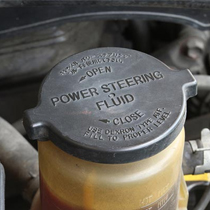
Low or contaminated power steering fluid
Fluid plays a key role in creating the pressure needed for steering assist. Low levels of contamination from dirt and moisture can reduce efficiency and make steering heavy.

Pump failure
The hydraulic pump circulates fluid under pressure. If it fails due to any damage, overheating, or belt issues, the system loses its ability to assist steering, especially during low-speed maneuvers.
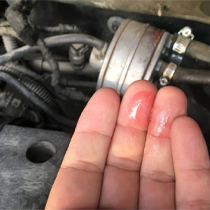
Leaks in hoses or seals
Damaged hoses or seals allow fluid to escape, lowering the pressure and performance. Even small leaks can lead to a complete loss of steering assist over time.

Blocked steering lines
Dirt, metal particles, or degraded fluid can block internal passages, restricting flow and reducing the pressure available to assist steering movements. It often develops gradually before causing noticeable symptoms.
Electric / Electro-Hydraulic Systems
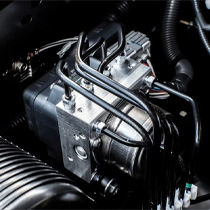
Faulty motor or control module
Electric motors and control units manage steering assist in EPS and EHPS systems. Failures can be due to overheating, internal damage, or manufacturing defects that cause intermittent or total loss of assistance.

Steering angle sensor failure
This sensor monitors steering wheel position to adjust assist levels. A fault can cause inaccurate reading, which leads to inconsistent steering assist or sudden changes in steering effort.

Electrical wiring issues or blown fuse
Damaged wiring, corroded connectors, or a blown fuse can disrupt power supply to the motor or sensors. This often triggers a warning light alongside a loss of assist.

Battery or alternator problems
EPS systems rely heavily on a stable electrical supply. A weak battery or failing alternator can limit motor power. Due to this failure, steering assist stops working, especially during high electrical demand.
General Causes
Physical damage to the steering rack : Impacts from potholes, accidents, or exterior strikes can damage the rack’s internal components. It leads to misalignment, fluid leaks, or complete mechanical failure over time.
Overheating of components : Excessive heat from long driving routines, high load conditions, or poor ventilation can damage both hydraulic and electric steering components. As a result, you will face reduced performance and steering lifespan.
Software glitches : Modern steering systems use electronic control software. Errors in programming or corrupt data can trigger false warnings or cause the assist to shut down until the system is reset or updated.
Other Symptoms You May Notice Alongside the Warning
When the “Power Steering Malfunction” alert appears, it often comes with additional symptoms. These can help identify the type and severity of the problem.
Faulty motor or control module : One of the first signs of a failing power steering system is a heavier steering wheel. This is most noticeable during parking or slow maneuvers, where more assistance is normally needed. A loss of assist at low speed can make the vehicle harder to control.
Steering angle sensor failure : Unusual sounds during steering can indicate fluid issues, pump failure, or mechanical damage in the steering rack. Whining sound often points to low or aerated fluid, while grinding sound may signal internal damage.
Battery or alternator problems : In many vehicles, the power steering system is linked to stability control and braking systems. A steering fault can trigger ABS or traction control warnings.
Electrical wiring issues or blown fuse : In many vehicles, the power steering system is linked to stability control and braking systems. A steering fault can trigger ABS or traction control warnings.
Immediate Actions When the Warning Appears
When the power steering malfunction warning comes on, responding correctly can prevent further damage and help keep you safe. Below are practical steps to follow.
Safely pull over
The first step is to find a safe location to stop the vehicle. A failing power steering system can make the wheel harder to turn, especially at lower speeds or during sharp turns. Gradually slow down, use your indicators, and pull over to the side of the road or into a parking area. Avoid sudden movements that could cause loss of control. Stopping suddenly allows you to assess the situation without the added pressure of traffic and reduces the risk of an accident if the steering assist fails.


Restarting the vehicle to rule out temporary glitches
In some cases, a power steering warning may be caused by a temporary electronic fault. Turning the engine off, waiting a few seconds, and restarting can reset the system and clear the warning. If the alert disappears, it could have been a brief sensor error. However, if the warning comes back after restarting, the fault is likely real and needs inspection from an expert car technician. Restarting the vehicle can help in diagnosing if the problem is intermittent, but it should never be considered a permanent fix or a reason to delay professional evaluation.
Checking power steering fluid (if applicable)
For vehicles with hydraulic or electro-hydraulic systems, fluid level and quality are critical. Open the hood and locate the power steering fluid reservoir, which is usually labeled and has a dipstick or fluid level markings. If the level is low, it can cause a loss of assist and trigger the warning. Dark, dirty, or foamy fluid can also reduce performance. Adding fluid may restore function temporarily, but a sudden drop usually points to a leak that must be fixed immediately. Always use the fluid type recommended by the manufacturer to avoid further issues.


Inspecting for leaks or belt damage
Leaks in hoses, seals, or the steering rack can lead to a drop in hydraulic fluid and a loss of steering assist. Belt-driven hydraulic pumps also rely on a properly tensioned belt to function. A damaged, cracked, or loose belt can cause intermittent assistance or complete failure. Visually inspect under the vehicle for fluid puddles, and check around the engine bay for wet spots on hoses and fittings. If you notice any damage to belt or fluid leakage, it is best to avoid driving the vehicle until the issue is addressed by a qualified technician.
When to call for roadside assistance
If steering effort is significantly increased or the vehicle becomes difficult to control, it is safest to stop driving and call for roadside assistance in Dubai. Continuing to drive with a faulty power steering system can put you and other road users at risk, especially during emergency maneuvers. A tow truck can transport the vehicle to a repair facility without causing additional damage. This is especially important if there are other warning lights active, if fluid is leaking heavily, or if you suspect electrical failure that could affect other safety systems.

How Mechanics Diagnose the “Power Steering Malfunction” Problem
When a vehicle is brought in with a power steering malfunction warning, a power steering repair specialist will first carry out a physical inspection of the system. He will start with checking fluid levels and then conditions in hydraulic or electro-hydraulic systems, leaks in hoses or seals, and making sure that all mechanical components are intact. For belt-driven pumps, the belt’s tension and damage are examined. These visual checks help identify obvious mechanical faults before moving on to more advanced diagnostics.
Next, the electrical side of the steering system is evaluated. A trusted luxury car workshop in Abu Dhabi will test fuses, wiring, and connectors to make sure there are no breaks or corrosion that is disrupting the flow of power. For electric power steering systems, a detailed check of the control module and motor is performed to detect faults or overheating. Using an OBD-II scanner, technicians retrieve fault codes from the vehicle’s onboard computer, which often pinpoint specific issues such as sensor failures, communication errors, or voltage drops.
Finally, the steering angle sensor is tested and calibrated if necessary, because incorrect readings can trigger the warning light. Once power steering repairs in Dubai or adjustments are made, the vehicle undergoes a road test to confirm that the steering assist is functioning correctly under real driving conditions.
Fixing Power Steering Problems – Common Repairs and What They Cost
Repairing a power steering malfunction begins with addressing the root cause identified during the diagnostic process. Depending upon the fault, there could be multiple solutions. We have listed below the repair solutions that are commonly faced by car owners:
Estimated Cost of Fixing Power Steering Malfunction
| Repair Type | Typical Issue | Repair Cost Starts From |
|---|---|---|
| Fluid Top-Up | Low fluid level due to minor leak or evaporation | 370 AED ($50) |
| Leak Repair | Damaged hose, seal, or fitting | 555 AED ($150) |
| Pump Replacement | Hydraulic pump failure | 1,480 AED ($400) |
| EPS Motor Replacement | Electric assist motor fault | 2,220 AED ($600) |
| Steering Rack Replacement | Worn or damaged rack | 2,960 AED ($800) |
| Sensor Replacement | Steering angle sensor or torque sensor fault | 740 AED ($200) |
Pro Tips for Preventing Power Steering Malfunctions
- Regularly check and change power steering fluid to maintain lubrication and prevent contamination that can damage internal components.
- Test and maintain the battery and alternator in electric power steering systems for a consistent power supply.
- Include a full steering system inspection during routine vehicle servicing to identify leaks, signs of damage, or sensor faults early.
- Avoid holding the steering wheel at full lock for long periods to reduce strain and overheating in both hydraulic and electric systems.
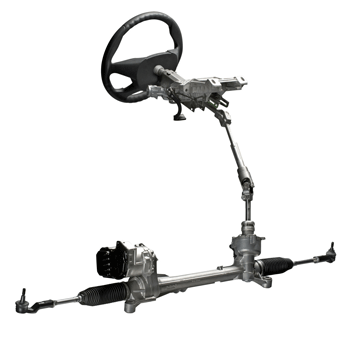
Top 5 Luxury Car Steering Systems – Common Issues by Brand
Luxury performance brands use advanced steering technologies for precision, comfort, and safety. These systems deliver exceptional driving experiences but can be more complex and costly to repair when faults occur.
Mercedes-Benz : Mercedes-Benz models often feature electro-hydraulic or full electric power steering with integrated driver-assist functions. Common issues include EPS motor malfunctions, fluid leaks from rack seals, and steering angle sensor miscalibration. When faults occur, the system may reduce steering assist to preserve control, accompanied by the message “Power Steering Malfunction – Visit Workshop.”
Lamborghini : Lamborghini’s high-performance steering systems are tuned for sharp response and stability at extreme speeds. Failures can result from EPS motor overheating during aggressive driving, sensor faults, or control module errors. A malfunction may trigger the “Steering Fault” message, and the system often shifts to a heavier steering mode rather than full assist loss to maintain stability.
Bentley : Bentley vehicles balance luxury comfort with accurate handling by using advanced electro-hydraulic steering systems. Common faults include hydraulic fluid leaks, pump damage, and electrical connection failures in EPS components. Warning messages may appear as “Power Steering Fault” and can result in a noticeable increase in steering effort, especially during parking maneuvers.
Rolls-Royce : Rolls-Royce steering systems prioritize effortless operation and smooth feedback. Hydraulic systems in older models may experience fluid degradation and cracked seals, while newer EPS-equipped models can face motor control unit failures. When a malfunction is detected, steering assist is gradually reduced to allow the driver to safely maneuver to a stop.
Ferrari : Ferrari’s performance-focused EPS systems are engineered for precision at high speeds. Common issues include overheating of EPS motors during track-style driving, calibration loss in steering angle sensors, and occasional rack wear. Faults may trigger “Steering System Failure” or “Steering Assist Reduced” messages, causing the system to adjust to a heavier steering feel for controlled operation.
Wrapping Up: Drive Safe, Drive Confident
A power steering malfunction is a safety concern that affects how well you can control your vehicle. Ignoring the warning can lead to more serious damage, higher repair costs, and potential hazards on the road. A timely power steering diagnosis in Dubai is necessary to diagnose the problem before it escalates.
Professional repair offers the expertise, tools, and genuine parts that are needed to restore the system to full function. DIY methods might seem appealing, but they can miss underlying issues or cause further complications, especially in modern vehicles with advanced electronics.
If your dashboard displays a power steering warning or your steering feels unusual, schedule a steering system inspection with a trusted auto repair specialist in Dubai. Acting early can save money, prevent breakdowns, and ensure a smooth and safe driving experience.




